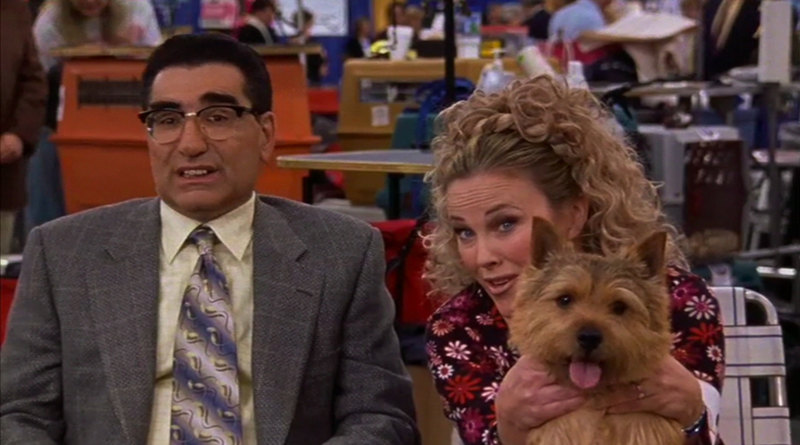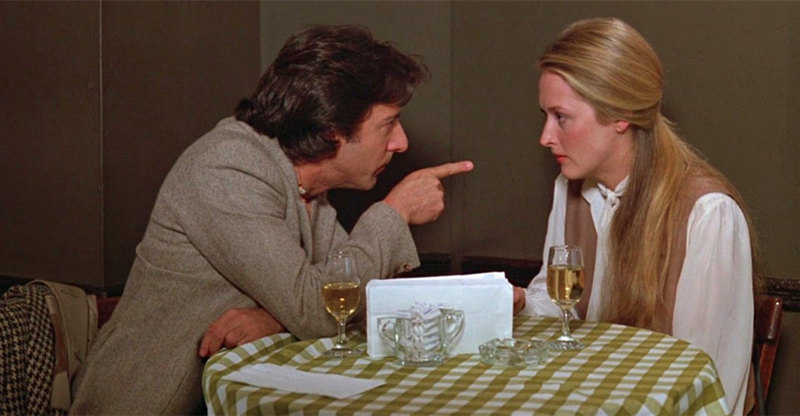Like Oliver Stone, who offers a commentary on the film and a dozen deleted scenes, I hadn’t seen “Platoon” for a good many years. Watching it again, 20 years after it won an Oscar for Best Picture, I was struck by a number of things.
1) The level of realism. Wow. From the moment that a plane drops “fresh meat” in country and leaves with a fresh cargo of body bags in September 1967, viewers enter a world where sights and sounds tell as much of the story as dialogue or Charlie Sheen’s voiceover narration as Chris Taylor, one of the new infantrymen. For the first 10 minutes, Stone uses no dialogue and no narration—just the ambient noises of the jungle and a lot of hand-held camerawork to show us, documentary style, what the jungles of Vietnam looked and felt like through those new pairs of frightened eyes. And the contrast between the veterans of Bravo Company and the new soldiers was just as shocking. If this place didn’t kill you, it changed you, and not for the better.
When we first hear Taylor speak, it’s like the HBO film “Letters Home from Vietnam,” with the young man writing his grandma that “I don’t think I can take this for a year. I think I made a big mistake.” Taylor stands out from the rest of the recruits, who are the “bottom of the barrel” poor uneducated troublemakers and castoffs of society. Taylor’s a bleeding heart liberal who joins partly to honor his grandfather’s service but mostly because he doesn’t think it’s fair that only the poor or non-whites end up doing most of the fighting in Vietnam. But one of the African-Americans tells him, “The poor always bein’ fucked over by the rich. Always have, always will.” Translation? You dumb rich white kid, your token empty gesture has just earned you a seat in this living hell. For much of the film, Stone is comfortable with long takes and silences, which help him to approximate, as best one can for a two-hour film, “real time.” The rough language, the way these soldiers treat each other and the enemy, the firefights and brutalities, the camera angles—all of it contributes to an extraordinary level of realism.
For that, you have to give Stone credit. He forced his actors to take part in a two-week boot camp in the Philippine jungles, during which they stayed in camp and in character the full time, ate canned rations, slept in the jungles (even taking turns on night watch), and were allowed no showers. And the actors who smoked dope on screen apparently did so prior to the scene. Now that’srealism.
2) The good cop/bad cop structure. I had forgotten how Sgt. Elias Grodin (Willem Dafoe) was the idealistic good-guy who was sensitive to the Vietnamese peasants and soldiers, while the scar-faced Sgt. Barnes (Tom Berenger) would kill you just as quick as he would order you into a tunnel to blow it. Sgt. Grodin, whose men called him Elias, blew those tunnels himself. One man was the face of humanity trying to stay human throughout an inhuman struggle, while the other was the unadulterated face of war and depravity. One man would pick through a village and kill only when certain a suspect was NVA; the other would torch the whole village and allow his men to do what they wanted. This dichotomous structure is echoed throughout the film, with soldiers separated by race, humanity level, and drug of choice (stoners vs. the Budweiser crowd).
3) Johnny Depp. When the end credits rolled and I saw his name and face, I had to rewatch scenes to see a pre-“21 Jump Street” Depp in action. Sure enough, he’s there as Gator Lerner. So is Keith David as King (whom you might remember as the “franks ‘n’ beans” father from “There’s Something About Mary!”) and Forest Whitaker as Big Harold (who would get another tour of duty in “Good Morning, Vietnam!”). Young Kevin Dillon is here too, as the psycho, sadistic, and ironically named “Bunny.” The cast does a great job of selling the language and zero-courtesy world of “grunts,” where the men routinely rag on each other and seem moments away from fistfights. “All you gotta do is make it out of here, and it’s gravy. The rest of your life is gravy.” Meaning, Vietnam was a death sentence, and if you beat the rap, you got a second life. If you can survive the bugs and disease, the oppressive heat and fungi, the snakes, the enemy, and your own sadistic and mentally unstable men, every day after that is a bonus.
4) The big offensive. I remembered “Platoon” as a slice-of-grunt-life story with background music from Georges Delerue that repeated like a sad “Bolero.” The tone of the film felt elegiac to me when I first saw it, and it still strikes me very much that way—and the end tile says that Stone dedicated the film to those who fought and died in Vietnam. But I had forgotten that the “crisis” scene had Taylor’s platoon being used as “bait” to flush out an enormous NVA force—a force so big that when the battle came, it felt very much like a Little Big Horn stand. So there’s more of a dramatic arc than I recalled.
5) The gold standard. When “Platoon” first showed, it felt like the movie about Vietnam, the way that “The Longest Day” felt like the movie about D-Day when it first came out, and “Tora! Tora! Tora!” felt like the movie about Pearl Harbor. After 20 years, “Platoon” still holds its place alongside “Apocalypse Now” as the gold standard for Vietnam War films. And until someone figures out a way to make a movie out of Tim O’Brien’s magical realist novel, Going After Cacciato, which is one helluva book and a film waiting to be made (Tim Burton, are you listening?), “Platoon” will remain the quintessential Vietnam War film. Its weaknesses are few. Some of Taylor’s voiceover narration is hokey, and Taylor’s schizophrenic personality isn’t fully explored so that we understand the reasons behind all of his actions. But that’s it. Everything else falls into place.
“Platoon” is rated “R” for language, extreme violence, and gore—and there’s plenty of all three.
Video: This release is touted as being “remastered in High Definition,” but Hi Def on a 20-year-old movie is not the same as Hi Def on a 2006 release. Especially in the title sequence there are visible flaws that morph in and out of your picture, with overexposed outdoor sequences. When the men get into the jungle and low-lit conditions the clarity gets closer to what we’ve gotten used to expecting out of Hi Def, and even at that there’s slight graininess throughout. The picture is presented in 1.85:1 anamorphic widescreen, and aside from the opening and one other scene where there are noticeable imperfections, the quality is pretty good.
Audio: The audio, though, was really juiced up for this 2-disc release, though the English DTS and English Dolby Digital 5.1 are pretty close to my non-audiophile’s ears, which is to say excellent and a big improvement over the initial 2.0 that this was released in. If I can put my finger on anything, it’s that the explosions and gunfire have a slightly brighter pop to them on the DTS soundtrack. Subtitles are in English, French, and Spanish.
Extras: Okay, this is what the 2-disc release is all about. Though I don’t have the Special Edition 2001 release in my collection to compare with this release, I suspect that the same commentaries by Stone and military advisor Capt. (Ret.) Dale Dye are identical to those on that DVD. Both are better than average, but Dye’s is actually packed with more information because he covers more ground than the plodding and laconic Stone. And we learn very quickly that he wasn’t your typical military advisor. He took it upon himself to “co-make” this picture, which the commentary makes absolutely clear. He trained the men in boot camp, and he was in the body bag that gets loaded in the airplane in the opening scene. There are lots of tidbits like that scattered throughout.
The excellent 50-minute feature on “Tour of the Inferno” also repeats from the 2001 release, which should be a relief for fans of the film. This extra is fantastic because it shows shots of a young Stone in the military and on the set, and covers the boot camp that the men went through to prepare for filming. No cut-and-paste schlock, this extra incorporates historical footage as well, so it’s great to have it in this set. Stone talks a lot about his time in the military, and we realize that he was the model for Taylor, and the other men were composites of real men he knew in the 25th Infantry and 1st Cavalry in Vietnam from 1967-68.
MGM put together two new documentaries for this release. One of them, “One War, Many Stories,” groups Vietnam vets in a theater talking about their experiences—a kind of focus group—which are then intercut with interviews with Stone talking about his own experience and vintage clips. A second bonus feature, “Preparing for Nam,” follows the same format with Stone on camera again, this time intercut with clips of basic training and other vintage clips. In both cases, it’s not the standard thrown-together mix of talking heads and clips from the film. Somebody actually took some care to do additional research and put together something new and original. All three documentaries are very good, as is the legacy-minded “Raw Wounds” and a contextual feature, “Snapshot in Time: 1967-68.”
Fans of the film will also appreciate a dozen deleted scenes, playable with or without commentary by Stone. One of them, a “dream sequence,” Stone flat-out labels “stupid,” so there’s no mystery why it was cut. The other interesting scene is an alternate ending that Stone says now that he should have used instead of the one he chose. More good stuff here, and the scenes are in better shape than most that are dragged kicking and screaming from the vault. Rounding out the extras are TV spots, the original trailer, and photo galleries of posters and behind-the-scenes still shots. All in all, MGM finally got it right. This is a great package.
One side note on the packaging: The two single-sided discs are housed in a single-width keep-case with a decorative acetate sleeve similar to those that Warner Brothers has been using for their TV cartoon releases. Count me among those who can never seem to slide these things on again very easily.
Bottom Line: Stone and his military advisor Dye said they wanted to make “the definitive film about Vietnam.” Given the heavily stylistic nature of “Apocalpyse Now,” the other serious contender for top dog, I’d say that they succeeded. “Platoon” captures the experience of Vietnam most accurately and realistically, while also managing to forge a modern fable about good and evil, and the ultimate powerlessness of individuals.


